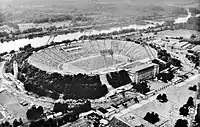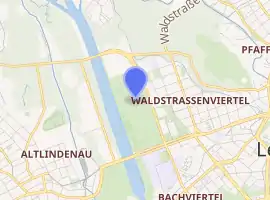Zentralstadion (1956)
Central Stadium (German: Zentralstadion German pronunciation: [tsɛnˈtra:lˈʃta:di̯ɔn]) was a stadium with a capacity of 120,000 in Leipzig which was initially used for matches of SC Rotation Leipzig.
 | |

| |
| Full name | Zentralstadion |
|---|---|
| Former names | Frankfurter Wiesen Stadion der Hunderttausend Sportforum Leipzig[1] |
| Location | Leipzig, Germany |
| Coordinates | 51°20′44.86″N 12°20′53.59″E |
| Owner | German Democratic Republic |
| Operator | Leipzig |
| Capacity | 120,000[2] |
| Record attendance | 100,000 (SC Rotation Leipzig - SC Lokomotive Leipzig, 9 September 1956) |
| Construction | |
| Built | 4 March 1955 |
| Opened | 4 August 1956 |
| Closed | 2000 |
| Demolished | Seats, fences and floodlights only |
| Construction cost | 9mio USD |
| Architect |
|
| Project manager | Walter Ulbricht |
| Tenants | |
| Deutscher Turn- und Sportbund DHFK Leipzig Trade Sports- Associations of sports societies in the GDR | |
About 1.5 million cubic metres of debris from the World War II bombing of Leipzig was used in the stadium's construction. Its name derives from the Soviet "Central Stadium".
Background
After the 1896 Summer Olympics, the city of Leipzig begun to plan a stadium. The Zentralstadion was built first for the sports students in the Sportforum Leipzig, with a capacity of 100,000. Next to it was an Olympic-style swimming stadium. After the sports university, rowing channel and the swimming stadium were established, plans were made for a new stadium downtown; Leipzig wanted to be awarded the Olympic Games. Blueprints by architect Werner March, the architect of Berlin's Olympiastadion, were used. Finishing the plan took 15 months, with 180,000 volunteers. Walter Ulbricht called the stadium "Stadion der Hunderttausend" (Stadium of 100,000), and made it the home of the German Gym and Sports Celebrations.
Construction
Part of Sports Forum Leipzig

After the War of the Fourth Coalition, educators Ernst Moritz Arndt and Friedrich Ludwig Jahn wanted German national sports celebrations to train the Lützow Free Corps to defend against the French.[4] Leipzig became one of the wealthiest cities in Germany, with a number of sports festivals; the only larger sports gathering was the 1936 Summer Olympics. Leader Walter Ulbricht wanted a national-class stadium to commemorate the 100,000 fallen soldiers in the Battle of Leipzig.[5]
Free German Youth regional leader Heinz Haferkorn was tasked with finding 200 volunteers per day,[6] and work on the stadium began on August 2, 1955. To save money, debris from the 1945 bombings was used. Its architect of record was Karl Souradny, who only completed the ground drawings and never visited the site.[6] A total of 180,000 volunteers worked for 735,992 hours on the stadium, which cost M28 million (DM5.6 million).[3] A small train brought debris to the stadium, which was mixed with ash, soil and water and compressed into bricks.[7]
Replacement
In 1990, due to riots in other European countries and in Leipzig's Alfred-Kunze-Sportpark, access to Zentralstadion was banned to reduce further rioting.[8] The bell in the stadium's Werner Seelenbinder Tower was silenced.[9]
Due to the rising maintenance costs, the city decided to build a smaller, soccer-only stadium in 1997. According to critics, Berlin's similar-size Olympiastadion was renovated at the same time and the Zentralstadion could have been saved. Germany won the right to host the 2006 Fifa World Cup in 2000, prompting renovation of many German soccer-specific stadiums (including the Olympiastadion).
Gallery
 Moving construction material
Moving construction material.jpg.webp) Aerial photo in 1956
Aerial photo in 1956 The Werner Seelenbinder clock tower
The Werner Seelenbinder clock tower The Zentralstadion packed with spectators on 4 August 1956
The Zentralstadion packed with spectators on 4 August 1956 The main entrance
The main entrance Model of the Sportsforums
Model of the Sportsforums
References
- Andreas Debski; Michael Kraske; Ingolf Rackwitz (2006). Zentralstadion Leipzig. Vom Stadion der Hunderttausend zum Fussballtempel. Das Neue Berlin. p. 20. ISBN 978-3360012807.
- "2. 1956 Leipzig vor 120000 Zuschauern /// FussballFanSeiten.de".
- Andreas Debski; Michael Kraske; Ingolf Rackwitz (2006). Zentralstadion Leipzig. Vom Stadion der Hunderttausend zum Fussballtempel. Das Neue Berlin. p. 25. ISBN 978-3360012807.
- Andreas Debski; Michael Kraske; Ingolf Rackwitz (2006). Zentralstadion Leipzig. Vom Stadion der Hunderttausend zum Fussballtempel. Das Neue Berlin. p. 9. ISBN 978-3360012807.
- Andreas Debski; Michael Kraske; Ingolf Rackwitz (2006). Zentralstadion Leipzig. Vom Stadion der Hunderttausend zum Fussballtempel. Das Neue Berlin. pp. 8–18. ISBN 978-3360012807.
- Andreas Debski; Michael Kraske; Ingolf Rackwitz (2006). Zentralstadion Leipzig. Vom Stadion der Hunderttausend zum Fussballtempel. Das Neue Berlin. p. 23. ISBN 978-3360012807.
- Andreas Debski; Michael Kraske; Ingolf Rackwitz (2006). Zentralstadion Leipzig. Vom Stadion der Hunderttausend zum Fussballtempel. Das Neue Berlin. p. 26. ISBN 978-3360012807.
- Andreas Debski; Michael Kraske; Ingolf Rackwitz (2006). Zentralstadion Leipzig. Vom Stadion der Hunderttausend zum Fussballtempel. Das Neue Berlin. p. 134. ISBN 978-3360012807.
- Andreas Debski; Michael Kraske; Ingolf Rackwitz (2006). Zentralstadion Leipzig. Vom Stadion der Hunderttausend zum Fussballtempel. Das Neue Berlin. p. 28. ISBN 978-3360012807.
Notes
- Video documentation: "Täve, Trümmer und Triumphe" | 23.09.2014 | 29:55 Min. | Broadcaster: Mitteldeutscher Rundfunk"
Further reading
- Andreas Debski; Michael Kraske; Ingolf Rackwitz (2006). Zentralstadion Leipzig. Vom Stadion der Hunderttausend zum Fussballtempel (in German). Das Neue Berlin. p. 191. ISBN 978-3360012807.
External links
| Wikimedia Commons has media related to Zentralstadion (Leipzig). |